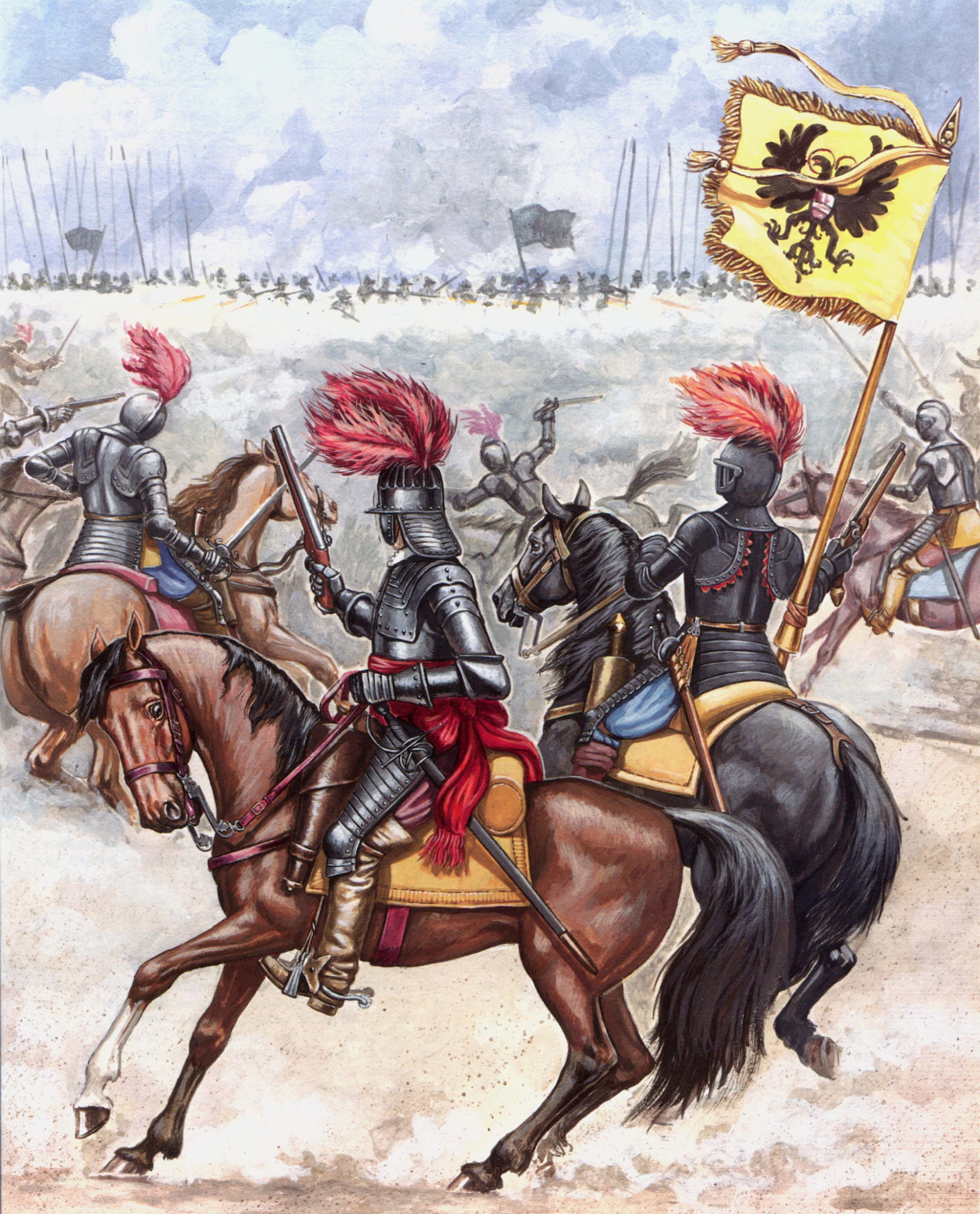
Towards the end of the sixteenth century, heavily armoured cavalrymen stopped using horse-armour, and reduced their own, becoming cuirassiers. The tactics of the reiters were adopted by all cavalry forces. Owing to improved weaponry and training, the depth of battle formation decreased first to ten lines, and towards the end of the century to six or seven. Shallower formations using the same number of men meant wider fronts, which had to be controlled by discipline and training. The cavalry of the period was therefore a modern force, acting as an organized troop.
The beginning of the seventeenth century saw several major conflicts. The Thirty Years War (1618-48) began as a religious war and turned into a clash between the feudal-Catholic reaction and the new social forces. The English Civil War (1642-8) saw a division along similar lines. Numerous armies crossed Europe, carrying new skills of war and tactical innovations, as well as the latest in weapons and equipment.
From the beginning of the seventeenth century, heavy cavalry consisted of the cuirassiers. They mostly wore three-quarter armour, and were armed with two pistols and a straight thrusting sword.
After 41 years of war, peace was made between Spain and the Netherlands in 1609. Part of the rich Dutch provinces had liberated themselves from Spanish rule and gained independence: the small professional Dutch army, commanded by Maurice of Nassau, stood against a world power. The most significant changes in the Dutch War of Independence were implemented in the cavalry. In 1597, out of a total of 11 ensigns of lancers (1,200 men in all), eight were converted to pistol-armed cuirassiers, and three to arquebusiers. The heaviest cavalry units rejected the lance in favour of firearms. The same year, at the Battle of Turnhout, the Dutch cavalry, practically on their own, routed Spanish cuirassiers armed with lances and infantry with long pikes.
From the Dutch border to Poland on the west and Turkey to the south were the semi-independent states dominated by the Austrian Habsburg dynasty. This whole area of central Europe, known for centuries as the Holy Roman Empire, was ruled from Vienna by the Austrian emperor, and the soldiers in his service were called simply ‘imperialists’. To distinguish themselves from other soldiers, they wore a red sash around their waists or over their shoulders and an oak twig in their helmets or hats.
At the turn of the century, imitating their Dutch counterparts, the imperial cuirassiers abandoned the heavy lance and began to use a pair of pistols. More reliable and lighter firearms were one factor which would shape their future strategy; another was the formation of infantry units several thousand men strong, half armed with muskets and arquebuses, the rest protecting them from heavy cavalry attacks with six-metre pikes.
In the early seventeenth century, the imperial works began producing armour which discarded all superfluous parts but strengthened the back and breastplates and headgear. Because of the materials used, cavalry armour became heavier and more massive. The heaviest models extant today are on show in the Landeszeughaus museum in Graz; they weigh 42 kg/90 lb. Their surface is unornamented, and their form not as refined as in previous phases: protection of the wearer against the improved firearms was paramount.
Cuirassiers played a prominent role in the Thirty Years War, commanded by Field Marshal Gottfried Pappenheim (1594-1632) and Albrecht Wallenstein (1583-1634). Pappenheim formed up his cuirassier regiments, about 1,000 men strong, in ten files of 100 men, stressing depth and narrowing the front. Wallenstein, on the other hand, disposed his units, of about the same strength, in six ranks emphasizing the initial strike over a wide front; his method was more successful.
Imperial cavalry
The Imperial cavalry was organised into four main branches: cuirassiers, harquebusiers, dragoons and Croats. The ideal cuirassier was armed in three-quarter armour, blackened to prevent rust. By 1632 few except officers wore these costly and uncomfortable suits. Most cuirassiers were now what Montecuccoli called `half cuirassiers’, wearing only breast and back plate, and open-faced helmet. The cuirassier’s main weapons were a sword and a pair of pistols, intended for close combat rather than `caracoling’.
Harquebusiers rode smaller horses and had little armour: most made do with a buffcoat. Named after their long arquebuses (carbines), they were intended for campaign duties and skirmishes, to save the cuirassiers for serious action. In reality the distinction between cuirassiers and harquebusiers was blurring. Many regiments were raised as harquebusiers and upgraded to cuirassiers when they acquired better equipment and horses. Piccolomini’s famous regiment was still officially a harquebusier unit, yet was better armoured than many cuirassier regiments.
All the Imperial dragoons engaged at Lützen seem to have been raised during 1632. They are described in the official army lists as `German horsemen, armed with half-armour (halb Harnisch, probably a breast plate) and equipped with firelocks (Feuergewehr)’. Though expected to carry out menial duties like their Swedish counterparts, they were listed as part of the cavalry rather than the infantry, and occasionally (as at Lützen) fought mounted.